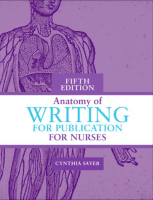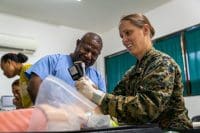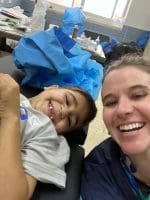My family and I have needed counseling for psychological trauma stemming from my ICU experience. It wasn’t the car accident itself (which I don’t remember) that caused my post-intensive care syndrome (PICS). It wasn’t even the risk of death, which I overcame. It was the fear I felt in the ICU that created the horrible memories I’ve had such trouble dealing with.
My mind took 6 months to recover normal function. I’ve returned to nursing school to get my bachelor’s degree and will graduate this semester–a sure sign that my cognitive abilities are finally back on track. No one would have believed this was possible if they’d seen me the first year after the accident. As for my body, it’s still healing 5 years later. I wear a leg brace because of muscle-nerve conduction problems. I wear special shoes and continue to struggle with chronic pain. I’ve experienced every element of PICS, but I’m healing gradually over time.
I invited my mother to help write this story with me and share her experience. But for her, the trauma was so great she couldn’t approach it directly to put her words on paper. It’s still too painful. She has encouraged me to share our story and let caregivers know how important it is to allow family presence during a loved one’s hospital stay and to keep the family informed, particularly at transfer points. My mother and I both know hospital discharge is, in a way, just the beginning of the journey. It was after my discharge that we realized we really needed help coping with the residual effects of my critical illness. Thankfully, the rehab staff were there for us.
What you’ve just read is an excerpt from one patient’s true story of her physical, cognitive, and mental-health problems stemming from her stay in the intensive care unit. (You can read the complete account online.) The constellation of problems she experienced, called PICS, can occur not just in patients but in their family members (called PICS-F), and may persist for an undetermined time after discharge. The cause of PICS and PICS-F remains unknown. (See Functional, cognitive, and psychosocial components of PICS by clicking the PDF icon above.)
At least one-third of ICU patients and their families experience PICS or PICS-F. Incidence is at least 50% among patients who’ve had sepsis or acute respiratory distress syndrome or were on a mechanical ventilator for more than 5 days. At least half of PICS patients still need some form of care 1 year after hospital discharge. The past decade has seen a tremendous increase in our understanding of the long-term effects of critical illness on patients and their families. As our PICS knowledge base continues to expand, the challenge is to inform healthcare providers who care for critically ill patients during and after their hospital stay of the potential consequences of ICU admission.
How nurses can help
PICS isn’t just an ICU issue. As a nurse, you can make a positive impact in various settings throughout the continuum of care. The strongest evidence to date supports that, for families of ICU patients, communication and information help minimize adverse outcomes. What caregivers say, how they say it, how soon, how often, and how it’s perceived by patients and families are factors that have been studied and seem to affect long-term consequences of critical illness. Early mobility is known to minimize both physical problems and delirium in ICU patients. Although more research is needed to verify which interventions can improve patient outcomes, the best evidence suggests clinicians can use certain strategies to minimize the negative effects of hospital stays.
ABCDE: Mitigating PICS in the ICU
Heavy sedation, delirium, and immobility are the main risk factors for PICS. Others include sepsis, hypoxia, and hypoglycemia. After assessing the patient’s and family’s risk factors for PICS and PICS-F respectively, the ICU team should implement strategies to mitigate them. The ABCDE bundle is a group of interventions that addresses the risks of sedation, delirium, and immobility. This tool supports the new guidelines on pain, agitation, and delirium published by the Society of Critical Care Medicine (SCCM).
A, B, and C
A, B, and C stand for airway management, spontaneous breathing trials, and coordination of care and communication among disciplines. To provide optimal ventilator management, the lightest levels of sedation, if any, should be used so patients can communicate and engage in activities. Heavy sedation causes immobility and resulting debilitation. Also, a heavily sedated brain may suffer cognitive or mental-health problems later. Analgosedation, based on the concept that pain commonly causes agitation, may be used to address pain and discomfort before sedatives or hypnotics are given, decreasing the need for benzodiazepines.
Using light sedation, in which the patient is calm yet awake and able to participate actively in care, helps optimizes outcomes. Daily awakenings (“holidays”) from sedation are an additional option. These should be coordinated so nurses and therapists are present to ensure patient safety and allow quick response to the needs of a more fully awake intubated patient.
Be aware that many medications used to treat pain have sedative effects. Using standardized tools to monitor pain, agitation, and sedation at routine intervals can allow the use of lighter sedation levels that enable patients to be somewhat physically active and keep the brain engaged. Of course, keeping patients occupied without self-extubating may mean more work for nurses. Family members can play a role in this regard; encouraging them to be involved can help safeguard their mental health while helping the nurse deal with a more fully awake patient.
D and E
D stands for delirium assessment and prevention. The new sedation guideline from the American College of Critical Care Medicine and SCCM suggests clinicians should avoid benzodiazepines in ICU patients (except in cases of alcohol or benzodiazepine withdrawal) because these drugs may be deliriogenic. No evidence supports using haloperidol to treat confusion or delirium. On the contrary, we know it can cause heart rhythm problems, including QTc prolongation and torsades de pointes (a type of ventricular tachycardia). Current recommendations are to:
- help prevent delirium by avoiding medications with deliriogenic risk
- perform vigilant medication reconciliation to reinstate medications taken before admission, when indicated
- promote early mobility.
E reflects the new focus on early mobility–the only strategy known to decrease delirium incidence. Early mobility also is linked to maintenance of cognitive and physical functions. The patient’s family can promote mobility by helping with passive range-of-motion exercises when out-of-bed activities aren’t possible; they can encourage active range-of-motion exercises when the patient is able to do these. Even intubated patients should increase their activity level as soon as possible. (Be aware, though, that insufficient therapists may be available to accomplish this, as getting an intubated patient out of bed requires a team effort. This means nurses can expect to spend more time assisting with the patient’s mobility efforts.)
The American Association of Critical-Care Nurses has posted evidence-based tools to help nurses use its “ABCDE bundle at the bedside” (www.aacn.org/pearl-abcde). For delirium-specific tools, visit www.mc.vanderbilt.edu/icudelirium/overview.html. Although these websites originally were meant for ICU staff, their tools and other resources are appropriate for every nurse.
Transitioning out of the ICU and hospital
The ABCDE bundle is part of a more extensive bundle called the ABCDEFGH bundle. (See Elements of the ABCDEFGH bundle by clicking the PDF icon above.) The FGH elements apply as the patient improves and transitions out of the ICU.
F
F stands for follow-up referrals, functional reconciliation, and family involvement. Referrals may be needed to address any element of PICS or PICS-F. At patient handoff to the next care provider, staff should review the PICS model developed by the SCCM as a guide to the types of referrals the patient may need. (See PICS model by clicking the PDF icon above.)
When a patient is discharged to the med-surg unit, nurses there should continue the mobility activities started in the ICU. To help improve continuity of care, act as a patient advocate. At handoff, let med-surg nurses know if the patient received early mobility efforts in the ICU. Once they know exactly how much and which types of activities the patient did in the ICU, they can continue these and build on them. Make sure the progress of post-ICU patients’ mobility and functional status is included in the transfer report.
Referrals may include respiratory, physical, occupational, and speech therapists. A physiatrist referral may be necessary for outpatient therapy to coordinate therapist treatments and care. Spiritual, financial, and case management referrals may be indicated, too. Psychological or psychiatric referrals may help the patient and family cope with their emotions.
A new concept in inpatient care is consistent functional reconciliation, in which the nurse compares the patient’s current functional status with what it was before hospitalization. Reconciliation includes therapies the patient required to achieve the current status. Next steps in the recovery plan are included in handoff communication. Hospital nurses should use a structured approach to pass this communication along shift to shift and across care-level transitions. When the patient first comes to the hospital, a baseline assessment should be done, just as it for medications, and then reconciled at each transition. Was the patient able to walk at home? Did any functional deficits exist before hospitalization? If so, what were they? Did he or she need adaptive devices, such as a cane or walker? Was the patient able to drive? Manage his or her own finances? Go shopping? Go to work? What activities would help the patient regain previous functional status?
Functional reconciliation requires close collaboration between nurses and therapists. Nurses should review therapists’ documentation, note the patient’s functional independence measure, and add a formal functional assessment to the handoff report to allow trending and adjustment of treatments and referrals.
Family involvement can aid baseline assessment and functional reconciliation at each transition point. Family members also can monitor follow-up referrals to verify that these occur and ensure the patient’s history and needs are communicated clearly.
G
G stands for good handoff communication. The handoff report should go beyond the standard head-to-toe format, making sure to include the family in its own section in every report. Med-surg nurses should consider PICS and PICS-F elements that may have been overlooked in the past, such as functional reconciliation of cognitive and mental function, mental-health problems, and physical problems.
H
H stands for hand the patient and family written information about the elements of PICS or PICS-F, as well as the patient’s potential needs. Unusual thoughts, mental-illness symptoms, and cognitive and functional losses can be frightening to the person experiencing them. Knowing that other ICU patients have had these problems can be comforting and could motivate the patient and family to find the outpatient care they need. Most patients with PICS would find comfort in knowing they’re not alone, abnormal, or unusual in experiencing this syndrome. As appropriate, refer patients and families to available resources. (See Web resources for PICS patients and families by clicking the PDF icon above.)
Lending an ear
Many PICS survivors and their families have long-term needs to talk to healthcare providers about their lingering problems after discharge. They may feel that only ICU clinicians can adequately address their questions 3 to 6 months after discharge. To help meet this need for communication, ICU team members should considering making follow-up phone calls to discharged patients and their families. (See A survivor’s story by clicking the PDF icon above.)
Creating post-ICU clinics (which are common in Canada, the United Kingdom, and northern European countries) may help address this need as well. In these clinics, patients and their families are debriefed by an advanced practice nurse and obtain referrals based on their individual needs. Models of post-ICU clinics currently are being tested for outcomes. Also, diaries kept jointly by family, ICU staff, and physicians and used for later debriefings have been shown to decrease mental-health problems for patients and families.
Healthcare providers need to go beyond saving the lives of critically ill patients. Now that we know about the potential long-term consequences of ICU stays, we need to devote extra time, effort, and attention to optimizing the physical, cognitive, and mental health of ICU patients and their families. Doing this isn’t easy, but it’s vital to ensuring the best possible outcomes.
To read the complete account of a nurse’s experience with PICS excerpted at the beginning of this article, please click the PDF icon above
Selected references
Balas MC, Vasilevskis EE, Burke WJ, et al. Critical care nurses‚Äô role in implementing the “ABCDE bundle” into practice. Crit Care Nurse. 2012;32(2):35-8.
Barr J, Fraser GL, Puntillo K, et al. Clinical practice guidelines for the management of pain, agitation, and delirium in adult patients in the intensive care unit. Crit Care Med. 2013;41(1):263-306.
Centre for Clinical Practice at NICE (UK). Rehabilitation After Critical Illness. NICE Clinical Guidelines, No. 83. London: National Institute for Health and Clinical Excellence; 2009.
Davidson JE. Facilitated sensemaking: a strategy and new middle-range theory to support families of intensive care unit patients. Crit Care Nurse. 2010;30(6):28-39.
Davidson JE, Daly BJ, Agan D, et al. Facilitated sensemaking: a feasibility study for the provision of a family support program in the intensive care unit. Crit Care Nurs Q. 2010;33(2):177-89.
Davidson JE, Jones C, Bienvenu OJ. Family response to critical illness: postintensive care syndrome–family. Crit Care Med. 2012;40(2):618-24.
Desai SV, Law TJ, Needham DM. Long-term complications of critical care. Crit Care Med. 2011;39(2):371-9.
Griffiths RD, Jones C. The intensive care unit diary and posttraumatic stress disorder. Crit Care Med. 2009;37(6):2145-6.
Jones C, Backman C, Capuzzo M, et al. Intensive care diaries reduce new onset post traumatic stress disorder following critical illness: a randomised, controlled trial. Crit Care. 2010;14(5):R168.
Jones C, Backman C, Griffiths RD. Intensive care diaries and relatives’ symptoms of posttraumatic stress disorder after critical illness: a pilot study. Am J Crit Care. 2012;21(3):172-6.
Melnyk BM, Crean HF, Feinstein NF, et al. Maternal anxiety and depression after a premature infant’s discharge from the neonatal intensive care unit: explanatory effects of the Creating Opportunities for Parent Empowerment program. Nurs Res. 2008;57(6):383-94.
Melnyk BM, Feinstein NF. Reducing hospital expenditures with the COPE (Creating Opportunities for Parent Empowerment) program for parents and premature infants: an analysis of direct healthcare neonatal intensive care unit costs and savings. Nurs Adm Q. 2009;33(1):32-7.
Melnyk BM, Feinstein NF, Alpert-Gillis L, et al. Reducing premature infants’ length of stay and improving parents’ mental health outcomes with the Creating Opportunities for Parent Empowerment (COPE) neonatal intensive care unit program: a randomized, controlled trial. Pediatrics. 2006;118(5): e1414-27.
Needham DM, Davidson J, Cohen H, et al. Improving long-term outcomes after discharge from intensive care unit: report from a stakeholders’ conference. Crit Care Med. 2012;40(2):502-9.
Schweickert WD, Hall J. ICU-acquired weakness. Chest. 2007;131(5):1541-9.
Vasilevskis EE, Ely EW, Speroff T, et al. Reducing iatrogenic risks: ICU-acquired delirium and weakness–crossing the quality chasm. Chest. 2010;138(5):1224-33.
Judy E. Davidson is director of Research Integration and Management at Scripps Health Davidson in La Jolla, California. Maurene A. Harvey is a critical care educator and consultant in Glenbrook, Nevada. Jessica Schuller is a staff nurse at Scripps Center for Integrative Medicine in La Jolla, California. Gary Black is a sepsis-awareness advocate and speaker, and author of the book Gyroscope: A Survival of Sepsis. He lives in Raleigh, North Carolina.



















2 Comments.
as A nurse for 25 years worked in almost all areas of nursing I feel that ICu nurses should be more mindful of the patients sedated condition,especially sedated condition,we should be considerate when we call each other,outside the cubicles and refrain from unnecessary conversations.ICU secrataries must be given incharge of reminding nurses to tone down when they forget their voice level reaches higher octaves in the interst of topics concerning their family orfashion issues.it disturbs the pts.